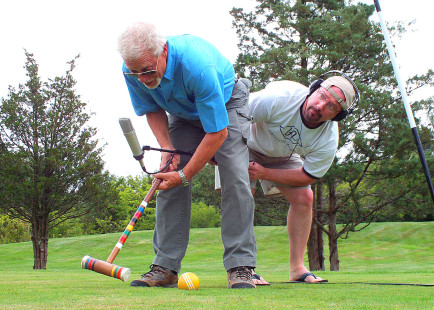 You can record voice-over just about anywhere, as voice pro Harlan Hogan (with the mallet) and audio geek Jeff Fisher humorously explain in their newly updated book, The Voice Actor's Guide to Recording At Home & On the Road.
Phone Patch Tech Improves: ‘Long
Distance Direction At Its Simplest’
By Jeffrey P. Fisher & Harlan Hogan
©2008 Reprinted with Permission from The Voice Actor’s Guide to Recording At Home & On the Road, Second Edition
Note: "Home Studio” is hardly a dry topic with industry pros Jeff Fisher (in book cover below, holding the mic) and Harlan Hogan (the VO driver) as your guides. Nor is it confusing.
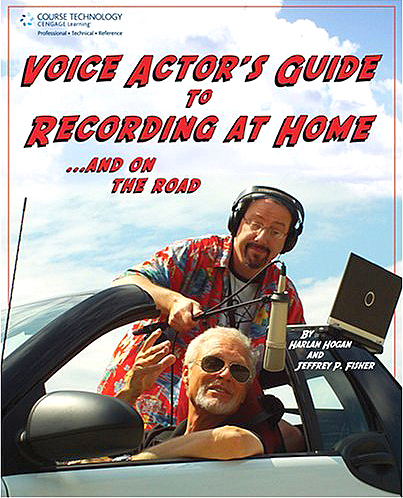 Their recently updated industry standard, The Voice Actor’s Guide to Recording At Home & On the Road, is a soup-to-nuts guide to creating an inexpensive but professional-sounding recording studio in your home. With lots of laughs! Their recently updated industry standard, The Voice Actor’s Guide to Recording At Home & On the Road, is a soup-to-nuts guide to creating an inexpensive but professional-sounding recording studio in your home. With lots of laughs! "The book is twice the size of the original, and although we kept it simple, we did add several advanced chapters for the folks who find themselves really interested and involved in audio production,” says Hogan, a veteran voice actor.
"And like in the last book, we had a lot of fun kidding ourselves and with some friendly debates between the geek (Jeff) and the actor (Harlan) – all tempered by our acerbic and imaginary editor, Prunella Sykes.
So, laugh and learn. In the Chapter 9 excerpt below, the authors review ways to communicate in real-time with producers while recording – including new phone patch technology ...
TELEPHONY TELEPORTATION ...
"I’m working on something that will change the world, and human life as we know it."
- Jeff Goldblum as Seth Brundle, The Fly, 1985, Brooksfilms
Well - we know just how well that teleportation-twisted-science-scheme worked out in all the various permutations of The Fly motion pictures. For voice actors though, telephony teleportation has made it possible for us (at least our voices) to travel – with broadcast quality sound – all around the globe; instantly.
Oh, when discussing telephony-based recording do not – under any circumstances – pronounce telephony (tuh-lef-uh-nee]) as tell a phony, or they’ll think you are one!
EARLY PATCHES
For many years, producers relied on the most basic form of long-distance recording: the ‘Phone Patch’ - and many sessions are still conducted using this kind of teleportation today.
Phone Patch sessions have a few drawbacks, though, because the bandwidth of ‘regular’ telephone lines – POTS, Plain Old Telephone Service – can’t send and receive audio at the level of quality needed for broadcasting.
Instead, the producer and talent use the telephone to hear each other for direction and performance, and the air-quality files are delivered after the session is over, usually on a recorded media like a CD or via the Internet.
SATELLITE SUPPORT
Because time was - and is - almost always of the essence with audio projects, other technologies emerged over the years.
For a brief period, many long distance sessions were produced using satellites. Quality audio flowed in both directions and the recorded tracks were ready to go on the air.
The downsides included:
ENTER ISDN
A better solution appeared in the late 1980’s - ISDN digital telephone lines. You can a few win bets in nerd-frequented bars (Where you’ll likely find Mr. Fisher - HRH) (Or a free VO: baseball cap at one of Harlan’s ‘Long Haul’ workshops - JPF) by knowing that ISDN stands for Integrated Services Digital Network. In the unlikely event you find it equally fascinating that ISDN was originally called "Integriertes Sprach und Datennetz," please close the cover of the book quietly and leave the room - now. ISDN BASICS Basically, two or more phone lines are used to send and receive data (our voices in this case) digitally on the ISDN lines, and like satellite transmission, the high-quality audio is instantly available. From a talent standpoint, recording via ISDN was and is, a dream come true. No commuting, no parking, no dressing (Harlan calls ‘em Boxer Sessions - JPF) (I call that disgusting - P). And unlike phone patch sessions, there is nothing to record and send on later, other than your invoice. However, ISDN for a home studio comes at a serious cost in gear and on-going telephone line fees. The very good news is that Internet-based solutions have been developed that are less expensive and can – in many cases – deliver as good a quality as dedicated ISDN lines. 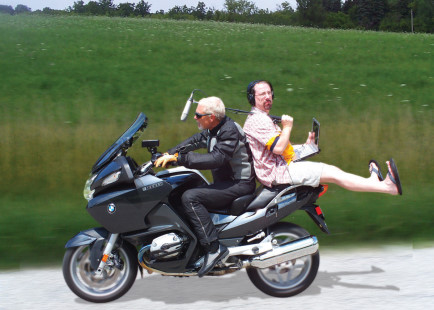 VO Harlan Hogan (driver) and audio geek Jeff Fisher have no fear of recording on the road.
FOR ROAD WARRIORS
You may want to be able to do long-distance sessions on the road, and most of the equipment we’ll discus for phone patches is small enough to take along and plug into an available telephone line or cell phone.
Although there are portable ISDN units, it’s rare to find the requisite ISDN digital phone lines installed in your hotel room or rented beachfront condo - although we’ve know a talent who had a local phone company do precisely that rather than be out of work.
Internet programs will generally work just fine, providing there is a reliable high-speed connection available.
A wise-road warrior carries both a traditional Pots phone patch device and an Internet program, so that in a worst-case scenario, they can at least record with telephone direction and then send the tracks moments later via the Internet.
TODAY’S PHONE PATCHES
Bottom line, as soon as you have the equipment and confidence to be doing honest-to-God going-on-the-air-tomorrow sessions from home, your producer will want to direct you.
And for that you’ll need a "patch” - which is just a long-distance talkback system. It’s long distance direction at it’s simplest.
The person directing the talent listens on a regular telephone line to your reading and gives direction.
Often, the director will be in a recording studio hearing you over a professional phone interface and studio speakers, but other times he or she will simply sit at their desk and listen on a regular, or speaker phone.
INEXPENSIVE INVESTMENT
It’s basic, inexpensive, and works well.
There are a few tricky parts though, and you’ll need some additional equipment to make this work smoothly.
Ideally, you’ll invest a few bucks on a professional telephone phone patch device that sits between your mixer and the telephone.
EMERGENCIES ONLY …
In an emergency, or if you are really pressed for cash, you can (we aren’t recommending this, except MAYBE for an audition) just record while holding the telephone up near your mouth.
The producer will hear your reading, but not the actual sounds you are recording, and depending on the quality of the telephone handset, may not hear you clearly enough to make good judgments about the sound and interpretation.
Some talents just use a telephone headset, which is easier than trying to hold the phone up to your mouth without blocking the microphone.
The best choice would be one that allows you to talk on the phone hands-free. You'll be able to hear the other parties on the line, and they'll hear you speak. At the same time you will, of course, be recording yourself properly through your regular microphone/recording setup.
The earpiece is just for communicating with people outside the session.
CAN’T RECORD PLAYBACK
There is one giant problem with this low-tech approach, though. If your client utters the following six words – you are screwed:
"Can I hear that take back?”
And the likelihood of the client asking to hear a take back? In our experience, about 90%.
GET THE PATCH
So, it’s best to purchase a professional telephone interface.
The good news? Phone patch interfaces are not prohibitively expensive, and many are quite portable too.
The MicTel made by CircuitWerkes (www.broadcastboxes.com) packs everything you need into a blue box about five inches long and two inches high and three inches wide, weighing in at one and a half pounds.
The MicTel and the other phone patch boxes we’ll talk about are built for broadcasters, so they are very rugged and reliable.
HOW IT WORKS
The MicTel runs on two 9-volt batteries for 20 to 35 hours. If your session takes more than that length of time – consider other means of employment or don’t ever work for that producer again!
In addition to professional connections (XLR), the MicTel functions as a mini-mixer. The latest version even features an output jack that lets you connect to your cell phone.
You’ll need a male-to-male 2.5mm plug to connect to your phone, and the longer the better, so that you don’t pick up annoying cell-phone buzz in the recording. Hosa makes a 10-foot long cord that is just perfect.
The MicTel uses your telephone’s electronics to work. When you are ready to record, unplug the handset from the telephone and plug it in to the interface.
Don’t try to use a telephone that has the keypad on the handset, because that means the electronics are located there rather than on the base. If you do, as you’ve probably guessed, the moment you unplug the handset the interface doesn’t have the telephone electronic "guts” to work with, and will just sit there looking up at you as sweat drips from your brow.
So use a more old-fashioned telephone and it’ll work great.
WORKS WITH CELL PHONE
Besides the possibility of saving money by using your cell phone instead of a pricey per-minute telephone in your pricey hotel suite, a cell phone can solve a problem you may encounter on the road.
Some hotel switchboards and systems are digital and incompatible with "regular” phone patch devices. (Harlan has only run into this problem once, but it does happen.)
Using a cell phone patch or the JK Innkeeper PBX described below is a solution.
THE DAPTOR PATCHES
Two really compact and convenient cell phone patch devices to also consider are the JK Audio Daptor 2 and Daptor 3.
Daptor Two works like the MicroTel, and although it has fewer inputs and outputs, it is smaller in size and less expensive.
Daptor Two also uses the 2.5mm headset jack to connect to your phone.
Daptor Three – the latest JK innovation - connects using Bluetooth wireless technology to your cell phone and your Bluetooth-enabled laptop!
For more, purchase The Voice Actor’s Guide to Recording at Home & On the Road, 2nd Edition. An autographed edition is even available.
Harlan Hogan has been voice acting for more than 25 years, giving voice to many recognizable ad campaigns, including, "It’s the cereal even Mikey likes,” and "Hey Culligan Man!” He’s also heard on countless documentaries and is the familiar voice on PBS saying, "This program is made possible by … Thank you.” Based near Chicago, he is also author of VO: Tales and Techniques of a Voice-Over Actor. His web site is www.harlanhogan.com, and email address, harlan@harlanhogan.com.
Jeffrey P. Fisher is the author of four books, and specializes in digital content creation, including words, music, sound and visuals. He works form his Illinois project studio on a variety of music, writing and multimedia products. His web site is www.jeffreypfisher.com, and email address, jpf@jeffreypfisher.com.
|
Tell Us What YOU Think!
Please Note: Since we check for spam, there will be a slight delay in the actual posting of your comment.
Comments (2)
LARRS JACKSON
7/29/2012 at 2:37 AM
HARLAN HOGAN IS MY HERO. THANKS FOR THE ARTICLE.
Don Griffith
4/5/2011 at 12:07 AM
Thanks! The phone patch article really decoded some "I don't knows" that I was carrying around! Much appreciated! Don



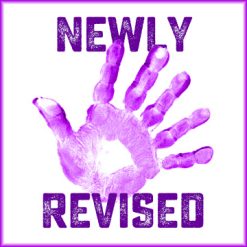
.png)
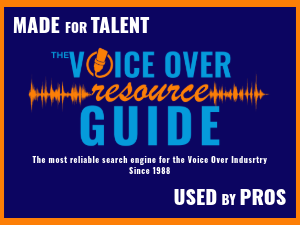



click for new article alerts